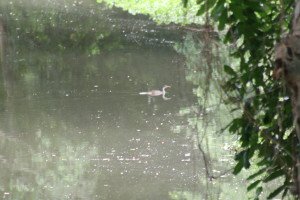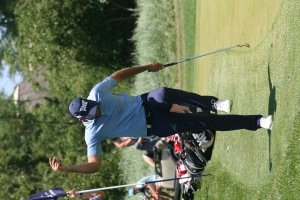Leopard Creek
Leopard Creek has recently been rated amongst the top 100 golf courses in the world by the prestigious Golf Digest magazine and it is surely the wildest top-class golf course in the world, situated as it is alongside the Kruger National Park.
The Crocodile River forms the northern boundary between Leopard Creek and the Kruger National Park and the back nine runs along the river, offering tremendous sightings of all the animals and birds made famous by one of the largest game reserves in the world.
A channel runs off the Crocodile River and flows right in front of the clubhouse, making the verandah of this opulent building an ideal spot for bird and animal spotting. Unfortunately the clubhouse is also extremely hard to access for the rank and file visitor to Leopard Creek, but the good news is that there is a little service road that runs along this channel for a hundred metres or so, before turning up the hill to the 10th tee.
Shaded by luxuriant riverine trees, the road passes right by the water and I always make a point of taking a quiet stroll along this area. It has always seemed to me to be a perfect spot for African Finfoot – which Roberts describes as favouring “quiet, wooded streams and rivers flanked by thick riparian vegetation and overhanging trees” – the very description of my favourite part of Leopard Creek.
And so, on my eighth visit to this special place outside Malelane for the Alfred Dunhill Championship, I finally got my Finfoot.
There in this shady channel I saw the bright orange legs first as the bird stood on the bank and then went into the water, gliding stealthily to the other side of the river.
A hippopotamus was contentedly passing the day between this channel and the main Crocodile River, while a Brownhooded Kingfisher called from high up in the trees and a Malachite Kingfisher hunted from low down on fallen branches close to the water.
Heuglin’s Robin, one of my favourites, also hangs around this area.
Coming back up out on to the golf course, a series of dams is in front of you between the ninth, 18th and 10th holes, with Lesser Striped Swallow flying over and African Pied Wagtail patrolling the banks.
Heading backwards through the front nine, Blackbacked Puffback is calling away and Blue Waxbill are in a sapling on the side of the ninth fairway.
The seventh hole, a par-three, shares a dam with the fifth hole, fringed by Fever Trees, and Spottedbacked, Southern Masked and Thickbilled Weavers were all nesting in the same specimen of this archetypal tree of tropical wetlands, from which gin and tonics (no doubt consumed in large quantities on the verandah of the clubhouse) originated.
Along the stream feeding this dam, a Giant Kingfisher was eating a good-sized fish, while a Greenbacked Heron was flying upstream.
Anywhere on the course, you are likely to see Whitebacked Vultures soaring overhead and Purplecrested Louries flying between patches of thicker bush. Whitefaced Duck are also often flying over.
But the 13th is the signature hole of Leopard Creek, not just because of its great design but mostly because of the dazzling vista it provides over the Crocodile River just beneath the elevated green and Kruger Park just across the way.
While sitting there on the final day and watching Charl Schwartzel’s challenge implode in the face of young Brandon Stone’s brilliance, I was able to admire Great White Egret, Purple Heron, Grey Heron, Black Crake, Egyptian Goose, Whitefronted Bee-Eater, African Elephant and Nile Crocodile along the river.
Away from the golf course, Leopard Creek is in an area of typical dense bushveld savanna with Forktailed Drongos, sometimes even perching on low aloes, ruling the day and Spotted Dikkops, marching around the parking lot, at night.
Sightings list
Forktailed Drongo
Spotted Dikkop
Impala
Bushbuck
Whitefaced Duck
Blackeyed Bulbul
Little Swift
Hippopotamus
Brownhooded Kingfisher
Malachite Kingfisher
African Finfoot
Heuglin’s Robin
Whitebacked Vulture
Lesser Striped Swallow
African Pied Wagtail
Blackbacked Puffback
Blue Waxbill
Spottedbacked Weaver
Southern Masked Weaver
Thickbilled Weaver
Giant Kingfisher
Grey Lourie
Greenbacked Heron
Yellowthroated Sparrow
Nile Monitor
Purplecrested Lourie
Great White Egret
Purple Heron
Grey Heron
Black Crake
Egyptian Goose
Whitefronted Bee-Eater
African Elephant
Nile Crocodile
Sombre Bulbul
Pintailed Whydah

